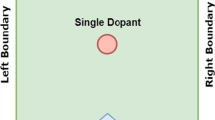Abstract
We study, by means of numerical simulations, the decoherence induced by a low-energy carrier-carrier scattering event on the spatial degrees of freedom of one of the two distinguishable carriers. The two-particle time-dependent Schrödinger equation is solved in the center of mass frame and the decoherence is quantified, at a number of time steps, by evaluating the entanglement between the two particles. We find that the decoherence rate is higher for higher kinetic energy of the particles and that a scattering between two carriers with opposite charge produces more decoherence than one between carriers with equal charge. The parallel algorithm used for the entanglement calculation is described.
Similar content being viewed by others
References
The concept of entanglement dates back to E. Schrödinger, Naturwissenschaften, 23, 807 (1935). For a general discussion on the relations between entanglement and statistics see, for example, A. Peres, Quantum Theory: Concepts and Methods (Kluwer Academic Publishers, The Netherlands, 1995).
M.A. Nielsen and I.L. Chuang, Quantum Computation and Quantum Information (Cambridge University Presss, UK, 2000).
D. Giulini, E. Joos, C. Kiefer, J. Kupsch, I.O. Stamatescu, and H.D. Zeh, Decoherence and the Appearance of a ClassicalWorld in Quantum Theory (Springer, New York, USA, 1996).
The parameters used in the simulations, performed in a single parabolic band approximation, are taken from M.E. Levinshtein and S.L. Rumyantsev, Handbook Series on Semiconductor Parameters, vol. 1, edited by M. Levinshtein, S. Rumyantsev, and M. Shur, World Scientific (London, UK), 1996).
F. Bassani and G. Pastori Parravicini, Electronic States and Optical Transistions in Solid (Pergamon Press, Oxford, 1975), Chap. 6.
J. Schliemann, J.I. Cirac, M. Ku, M. Lewenstein, and D. Loss, Phys. Rev. A, 64, 22303 (2001). P. Zanardi, Phys. Rev. A 65, 42101 (2002).
V. Vedral, M.B. Plenio, M.A. Rippin, and P.L. Knight, Phys. Rev. Lett., 78, 2275 (1997).
L.S. Blackford et al., “ScaLAPACK User's Guide”, Society for Industrial and Applied Mathematics (Philadelphia, USA, 1997).
W.H. Press, S.A. Teukolsky, W.T. Vetterling, and B.P. Flannery, Numerical Recipes (Cambridge University Presss, UK, 1986).
Author information
Authors and Affiliations
Rights and permissions
About this article
Cite this article
Bertoni, A. Simulation of Electron Decoherence Induced by Carrier-Carrier Scattering. Journal of Computational Electronics 2, 291–295 (2003). https://doi.org/10.1023/B:JCEL.0000011440.86454.13
Issue Date:
DOI: https://doi.org/10.1023/B:JCEL.0000011440.86454.13




